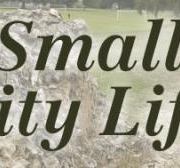I walk up to Shaw’s Corner, stepping passed the green gates and onto the curved gravel path. The climbing hydrangeas completely cover the front façade in white blossom. The front door has a swirling Arts and Crafts design set in glass and the brass knocker is of Shaw’s head wearing a hat. I pause to have a closer look, almost expecting the disgruntled ghost of Jacob Marley to jump out at me!
I’m greeted by a guide who explains that this Edwardian villa was home to the Irish playwright, George Bernard Shaw for over forty years. It is now owned by the National Trust, and is set up much as he left it.
I enter the study, and am standing on a worn out Indian rug. Everything feels as if it is in its right place. The Underwood typewriter takes centre stage on the wooden desk. The room is furnished with old filing cabinets, wall-to-wall shelves packed with books and papers, an antique sofa and some old leather suitcases. On the walls are some interesting prints by Aubrey Beardsley and a portrait of William Morris.
The mantelpiece in the dining room is a central feature and is filled with curios including a sketched portrait of Mahatma Gandhi and a black and white photo of the house where Shaw was born in Dublin; copies of Science of Life magazines are piled on the dining table.
As I climb the stairs to this spacious house, it feels perfectly proportioned; its tall windows letting in ample light. On entering the museum room I see Shaw’s Nobel prize for Literature beside a copy of Pygmalion and some black and white photos from the 1938 film. Wow! Then I see an Oscar statuette in a glass cabinet. Some of its gold coating has worn off. I’m impressed, although apparently Shaw used it as a doorstop!
I go back downstairs, walk through the kitchen and step out onto the huge garden. The tranquil grounds are vast and feel private. I walk across the lawn, my only distraction, the occasional ripple of a butterfly wing. I’m fascinated that the revolving hut could face any direction Shaw wanted and can’t wait to see it.
As soon as I peer into the window, I observe how Shaw arranged his creative space. It is Spartan with nothing but a bunk, a desk and a typewriter with a pair of spectacles resting beside it. I imagine him making the walk at the beginning of each day and realize that it is here within this small space that he would bring the wealth of his imagination to life with every deliberate tap of his typewriter.
I look back at the house in the distance, pine cones are strewn across the ground at my feet. It is here that that Shaw was able to write in peace; behind these towering tree trunks, perfectly secluded and hidden from his fame.


